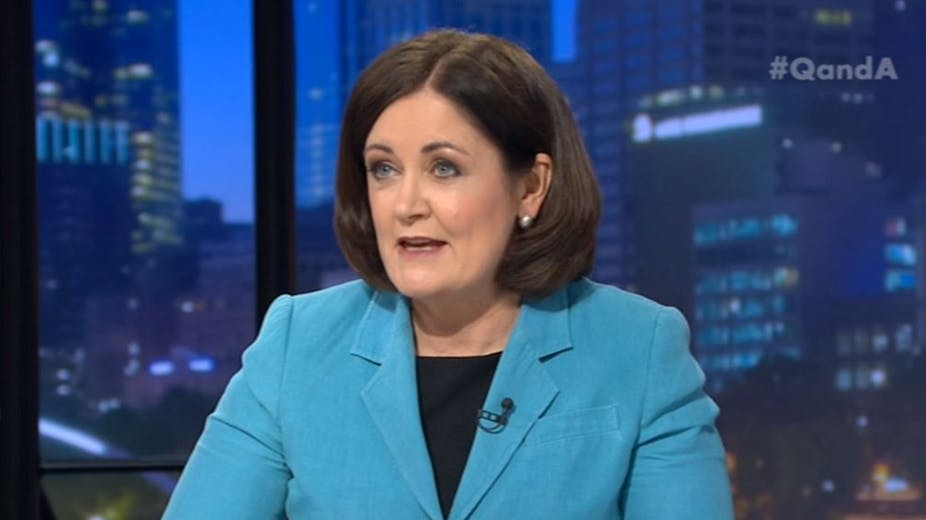The Conversation fact-checks claims made on Q&A, broadcast Mondays on the ABC at 9.35pm. Thank you to everyone who sent us quotes for checking via Twitter using the hashtags #FactCheck and #QandA, on Facebook or by email.
We’ve delivered more than a million jobs in the last year.
And 65,000 or so new businesses have started up.
Now, in Labor’s last year, 61,000 businesses closed.
– Liberal MP Sarah Henderson, speaking on Q&A, July 2, 2018
On Q&A, Liberal MP Sarah Henderson made the case for company tax cuts, saying the Coalition government’s “focus on backing business” was paying dividends.
“We are seeing a renewed sense of confidence because of our focus on backing business – small, medium and large – giving them the incentive to grow, to invest and to employ more people.”
Henderson said the Coalition had “delivered more than a million jobs in the last year, and 65,000 or so new businesses have started up”.
The member for Corangamite added that “in Labor’s last year, 61,000 businesses closed”.
Are those numbers correct?
Checking the source
In response to The Conversation’s request for sources, Henderson pointed to Australian Bureau of Statistics Counts of Australian Businesses data that show:
- an increase of 66,755 businesses in the 2016-17 financial year, and
- a decrease of 61,614 businesses in the 2012-13 financial year (the last financial year of the Labor government).
Regarding the employment figures, Henderson told The Conversation she had made an error, and had meant to say that more than one million jobs had been created over nearly five years.
Verdict
Liberal MP Sarah Henderson’s statement that the Coalition government “delivered more than a million jobs in the last year” was incorrect.
As Henderson noted in her response to The Conversation, growth in employment of “more than a million jobs” took place over more than four years.
Depending on which interpretation of “last year” we use – whether financial, calendar or year-to-date – the growth in the number of people employed was between 251,500 and 383,000.
In terms of whether the Coalition “delivered” these jobs, it’s important to remember that government policy is only one of many factors that determine employment dynamics. Changes in employment levels are never solely due to the efforts of any one government.
Regarding the numbers of businesses opening and closing, Henderson was correct.
In 2016-17 (the last financial year for which data are available), the total number of businesses in Australia increased by 66,755.
In the last financial year of the Labor government (2012-13), the total number of businesses decreased by 61,614.
It appears that the annual balance between business entrants and exits is correlated with the economic cycle.
Did the Coalition deliver ‘more than a million jobs in the last year’?
No.
As Henderson noted in her response to The Conversation, this statement was incorrect.
The growth in the number of people employed in “the last year” was between 251,500 and 383,000, depending on which interpretation of “last year” we use – whether financial year, calendar year or year-to-date.
The latest available employment data are the Australian Bureau of Statistics Labour Force figures ending in May 2018.
The labour force survey includes three different series of employment data: original, trend, and seasonally adjusted.
The “original” series simply counts how many people are employed at any given time.
The “seasonally adjusted” series adjusts the original series to account for regular fluctuations in employment due to the calendar or seasonal pattern of certain economic activities – for example, tourism.
The “trend” component tells the story of the underlying, longer-term dynamics of employment by smoothing out the peaks and troughs due to short-term fluctuations in economic activity.
Any of the three measures can be used, but trend or seasonally adjusted employment are typically more relevant when it comes to economic policy-making. So in this FactCheck, I’ll look at the trend data.
These show that for the 12 months from June 2017 to the end of May 2018, the number of people employed in Australia increased by 277,300.
If we look at the last financial year for which we have complete data, ending June 2017, trend employment increased by 251,500 people.
And if we look at the last completed calendar year – 2017 – then the increase in employment amounts to 383,000.
To count “more than a million jobs”, we need to look back around four or five years.
Trend employment data show an increase of one million people employed between June 2014 and May 2018, and looking a little further back, between September 2011 and June 2017.
In terms of whether the Coalition “delivered” these jobs, it’s important to remember that government policy is only one of many factors that determine employment dynamics in a given period of time. Changes in employment levels are never solely due to the efforts of any one government.
Other factors that influence employment levels include (and are certainly not limited to):
- federal policies
- economic conditions in trading partner countries
- changes in the international price of commodities, and
- variations in the level of the interest rate and/or the exchange rate.
It’s difficult to establish with certainty the relative contribution to employment growth of each of these factors.
How many businesses started and closed?
To test these claims, we can look to the Australian Bureau of Statistics Business Register. The register provides a count of actively trading Australian businesses, excluding those with turnover below $75,000 that have not registered for GST.
In the 2016-17 financial year – the last full year of data under this Coalition government – 328,205 new business were registered and 261,450 existing businesses were closed.
This leaves us with a net increase of 66,755 businesses – in line with the “65,000 or so” quoted by Henderson.
Labor’s last term in government ended in September 2013. In the 2012-13 financial year, 239,229 new businesses were registered and 300,843 existing businesses were closed.
The net balance was a loss of 61,614 businesses. Again, this figure is in line with Henderson’s statement.
The annual turnover rate (the sum of exits and entries in proportion to total business) between 2007 and 2017 was around 30%.
It appears that that the annual balance between business entrants and exits is correlated with the economic cycle. That is – the more severe economic contractions are associated with higher exits, and lower entries. – Fabrizio Carmignani
Blind review
The conclusions in this FactCheck are correct.
I would have used employment changes from the same month in the previous year.
The practice of politicians to claim that they have “delivered” the change in total employment over a period is erroneous.
Isolating the contribution of government policy to employment growth is a much more complex exercise. – Tim Robinson

The Conversation’s FactCheck unit was the first fact-checking team in Australia and one of the first worldwide to be accredited by the International Fact-Checking Network, an alliance of fact-checkers hosted at the Poynter Institute in the US. Read more here.
Have you seen a “fact” worth checking? The Conversation’s FactCheck asks academic experts to test claims and see how true they are. We then ask a second academic to review an anonymous copy of the article. You can request a check at checkit@theconversation.edu.au. Please include the statement you would like us to check, the date it was made, and a link if possible.

